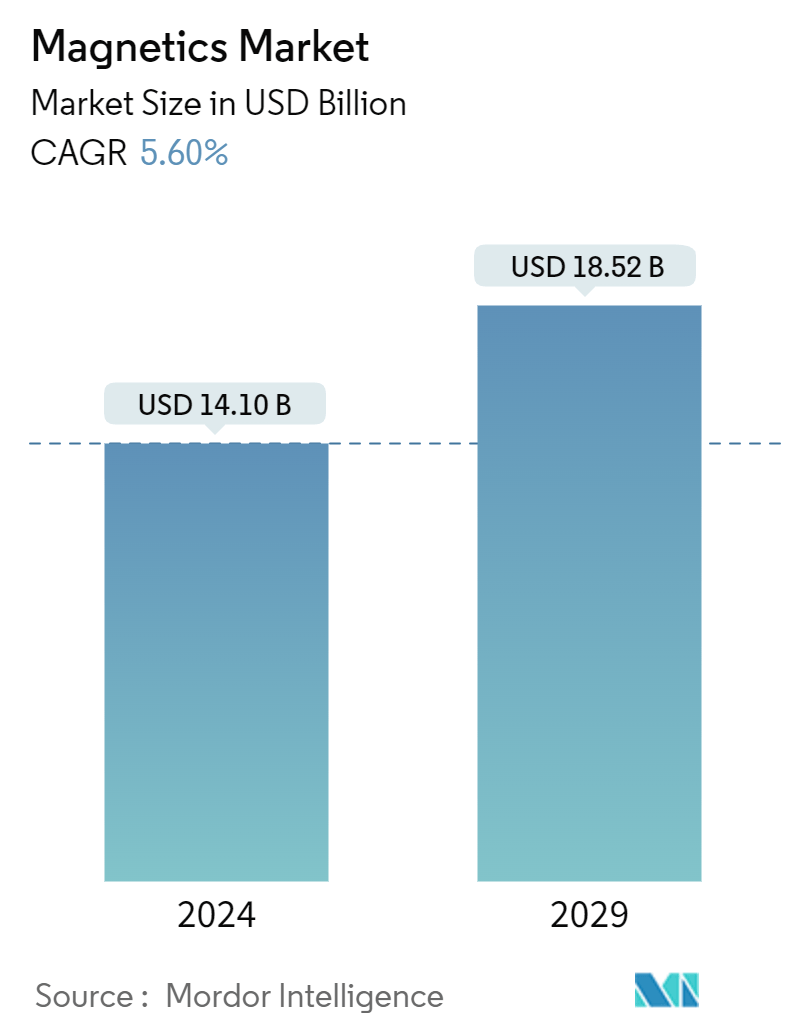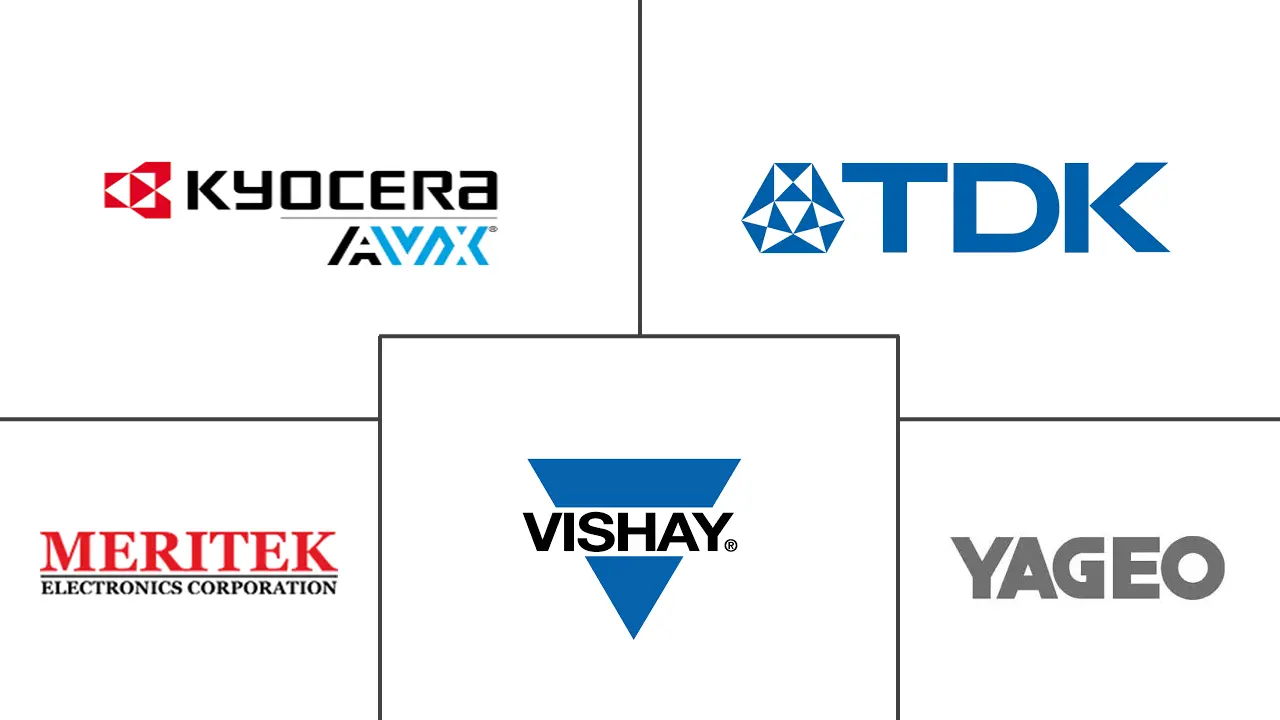Market Size of Magnetics Industry

| Study Period | 2024 - 2029 |
| Market Size (2024) | USD 14.10 Billion |
| Market Size (2029) | USD 18.52 Billion |
| CAGR (2024 - 2029) | 5.60 % |
| Fastest Growing Market | Asia Pacific |
| Largest Market | Asia Pacific |
Major Players
*Disclaimer: Major Players sorted in no particular order |
Magnetics Market Analysis
The Magnetics Market size is estimated at USD 14.10 billion in 2024, and is expected to reach USD 18.52 billion by 2029, growing at a CAGR of 5.60% during the forecast period (2024-2029).
Magnetic components are widely adopted in both advanced industrial and common household appliances, ranging from refrigerators and televisions to telecommunication devices. Magnetics plays a crucial role in cars, monitoring voltage in power supplies for dashboard displays, interior and exterior lighting, climate control, and other systems. These components are used in cell phones, computers, communication systems, and other electronic products.
- The global demand for HPC and AI is exploding. Similarly, the demand for smartphones, PCs, and infrastructures is stabilizing. Smartphone sales are expected to recover significantly in 2024, driving the demand for these magnetic components. High-frequency inductors are used in mobile phones, which help with fast and stable internet surfing. Furthermore, with the advancement in mobile communication networks, the number of inductors in smartphones is growing significantly. Inductors enhance various smartphones’ functions, including improving color LCD and battery life.
- Smartphone OEMs are ramping up Artificial intelligence-enabled smartphones in 2024, with generative AI capabilities and an additional storage capacity, which creates demand for better battery life. Further, with the advancement in technology, consumers prefer advanced technology products compared to older devices, which drives the sales of smartphones.
- The need for inter-country power grid connections (super grid) and renewable energy sources based on direct currents, such as fuel cells, wind power, and solar power, is expanding globally, as is the demand for magnetic components.
- Traditionally, transformers were made of solid iron; however, with the development of materials, silicon steel, amorphous steel, and ferrite ceramics have been used as core materials for transformers due to their higher penetrability. Similarly, inductors and EMI filters use iron, ferrite, and other magnetic materials as core material, and coils are usually made of copper.
- With the current rapid evolution of autonomous driving technologies and ADAS, automobiles are prepared with numerous sensors such as radars, cameras, and LiDAR, resulting in dramatic growth in magnetic components. Owing to ongoing advancement in automotive sector, key vendors are continuously investing on product developments and advancement to meet consumer demand.
- For instance, in January 2024, TDK Corporation launched a new inductor KLZ2012-A series, designed for automotive audio bus (A2B) applications with high durability, a wide operation range, and greater inductance tolerance. The company announced that the mass production of these new product series started in January 2024. A2B technology was developed to decrease the weight of cable harnesses containing of a broad variety of telecommunication buses, pointing at its final goal of amplified fuel efficiency of automobiles.
Magnetics Industry Segmentation
Magnetic components are widely adopted in both advanced industrial and common household appliances, ranging from refrigerators and televisions to telecommunication devices. Magnetics plays a crucial role in cars, monitoring voltage in power supplies for dashboard displays, interior and exterior lighting, climate control, and other systems. These components are used in cell phones, computers, communication systems, and other electronic products. These components help in optimizing power efficiency.
The magnetics market is segmented by type (wire-wound inductor, multi-layer inductor, thin film inductor, ferrite cores and EMC components, EMI filters, RF/power transformers, current sense, and other transformers), end-user application (photovoltaics and wind, EV/HEV, industrial [Motors/UPS], rail/transportation, consumer electronics, and other end-user applications), geography (China, Japan, United States, Taiwan, Southeast Asia, South Korea, Europe, Rest of the World). The report offers market forecasts and size in value (USD) for all the above segments.
| By Type | |
| Wire Wound Inductor | |
| Multi-layer Inductor | |
| Thin Film Inductor | |
| Ferrite Cores and EMC Components | |
| EMI Filters | |
| RF/Power Transformers | |
| Current Sense and Other Transformers |
| By End-user Application | |
| Photovoltaics and wind | |
| EV/HEV | |
| Industrial (Motors/UPS) | |
| Rail/Transportation | |
| Consumer Electronics | |
| Other End-user Applications |
| By Geography | |
| China | |
| Japan | |
| United States | |
| Taiwan | |
| South East Asia | |
| South Korea | |
| Europe | |
| Latin America | |
| Middle East and Africa |
Magnetics Market Size Summary
The magnetics market is poised for significant growth, driven by its integral role in both industrial and consumer electronics. Magnetic components are essential in a wide range of applications, from household appliances like refrigerators and televisions to advanced automotive systems and telecommunications devices. The market is experiencing a surge in demand due to the rapid advancements in technology, particularly in areas such as high-frequency inductors for mobile phones and the increasing adoption of AI-enabled smartphones. The automotive sector, with its growing reliance on sensors and autonomous driving technologies, is also contributing to the market's expansion. Additionally, the shift towards renewable energy sources and the need for inter-country power grid connections are further propelling the demand for magnetic components.
China plays a pivotal role in the global magnetics market, with its robust electronics manufacturing industry driving the demand for passive components. The country's dominance in producing electronic devices, including laptops and smartphones, is supported by its extensive manufacturing hubs and a large consumer market. China's strategic initiatives in the electric vehicle sector have also positioned it as a leading producer of lithium batteries, further boosting the magnetics market. The market is characterized by a mix of established players and new entrants, with companies like TDK Corporation, Yageo Corporation, and Vishay Intertechnology leading the way. These companies are continuously investing in product innovations and strategic partnerships to maintain their competitive edge in the evolving market landscape.
Magnetics Market Size - Table of Contents
-
1. MARKET INSIGHTS
-
1.1 Market Overview
-
1.2 Industry Attractiveness - Porter's Five Forces Analysis
-
1.2.1 Bargaining Power of Suppliers
-
1.2.2 Bargaining Power of Buyers
-
1.2.3 Threat of New Entrants
-
1.2.4 Threat of Substitutes
-
1.2.5 Degree of Competition
-
-
1.3 Technological overview of Magnetic Device Categories
-
1.4 Assessment of Macro trends in the Market
-
-
2. MARKET SEGMENTATION
-
2.1 By Type
-
2.1.1 Wire Wound Inductor
-
2.1.2 Multi-layer Inductor
-
2.1.3 Thin Film Inductor
-
2.1.4 Ferrite Cores and EMC Components
-
2.1.5 EMI Filters
-
2.1.6 RF/Power Transformers
-
2.1.7 Current Sense and Other Transformers
-
-
2.2 By End-user Application
-
2.2.1 Photovoltaics and wind
-
2.2.2 EV/HEV
-
2.2.3 Industrial (Motors/UPS)
-
2.2.4 Rail/Transportation
-
2.2.5 Consumer Electronics
-
2.2.6 Other End-user Applications
-
-
2.3 By Geography
-
2.3.1 China
-
2.3.2 Japan
-
2.3.3 United States
-
2.3.4 Taiwan
-
2.3.5 South East Asia
-
2.3.6 South Korea
-
2.3.7 Europe
-
2.3.8 Latin America
-
2.3.9 Middle East and Africa
-
-
Magnetics Market Size FAQs
How big is the Magnetics Market?
The Magnetics Market size is expected to reach USD 14.10 billion in 2024 and grow at a CAGR of 5.60% to reach USD 18.52 billion by 2029.
What is the current Magnetics Market size?
In 2024, the Magnetics Market size is expected to reach USD 14.10 billion.

